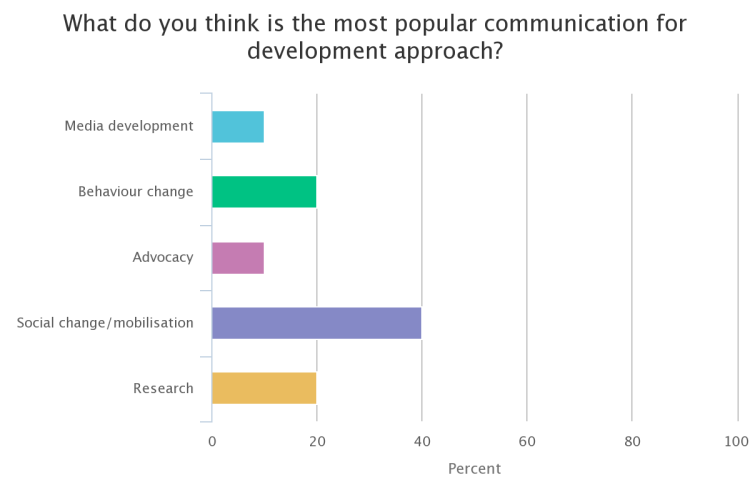Mapping the C4D Landscape: key findings from the 2016/17 C4D Network Mapping Study
On 27 July we held the second episode of the Research Uptake Roundtable webinar series, with guests from the Communication for Development Network (C4D) who discussed their network mapping study and its findings.
Nyasha Musandu, Research to Action’s Learning Coordinator, facilitated the discussion, and was joined by panellists Tatiana Joiro Rodriguez (consultant for C4D), Angelo Matinada (network manager of C4D) and Cecilia Agrinya-Owan (a member of the C4D Network and a Communication Specialist and Business Development Associate for Caritas, Nigeria).
If you missed the webinar, you can view a video recording on Vimeo and Youtube (coming soon) or find the presentation and resources on Slideshare.
Discussion
Tatiana began by introducing the C4D network, a community of practitioners working on communication for development and operating in 136 countries with over 3,000 members online.
Next, Tatiana explained the rationale for the network mapping challenge, conducted in over 50 countries, which aimed to find out about more about C4D in practice. It was the first ever annual ‘temperature taking’ exercise conducted about the C4D landscape, investigating the important C4D factors in different contexts. Data was collected for six different questions via 16 network meet-ups held in chapter countries and an online survey for those who could not attend meet-ups.
The network’s definition of C4D was given as ‘the strategic use of communication processes and tools to achieve development and human rights goals’.
The panellists shared a number of insights and themes drawn from the mapping study:
- Emerging themes in the MENA region were entrepreneurship, economic empowerment, and ICT4D, with examples of C4D including phone apps for refugees in Syria.
- The most significant strategies and approaches to C4D were behavior change (with 63 mentions), advocacy (with 50 mentions) and then media development (with 36 mentions).
- Communication channels most prominently mentioned included: social media which has the ability to reach young audiences, broadcast media such as radio dramas and also, community dialogues, films and storytelling.
- Engagement by donors sometimes confuses C4D with ‘communication with the media’. Lots of people are involved and are already doing C4D without even realizing.
- There is a lack of understanding of C4D, and consequently, there are less job offers out there, perhaps because human resources departments might not acknowledge the role. There is a need to train professionals in monitoring and evaluation, to demonstrate and prove the impact of C4D. There is potential to jointly provide training, delivered by donors and educational institutions. For example, there is a partnership between UNICEF and Rafel Landivar University in Guatemala.
Interesting examples of C4D uncovered by the mapping exercise included:
- Guatemala’s National Strategy for the Prevention of Chronic Undernutrition which had a C4D component.
- Colombia’s Ciudad Comuna, a participatory video and photography project to build a collection of memories about the civil war.
- Uganda’s Ministry of Health which is undertaking capacity building in C4D for Health Promotion Officers across the 47 counties.
- Papua New Guinea’s Media for Development Initiative a partnership between ABC International Development, the PNG National Broadcasting Corporation and Australian Aid.
Nyasha began the audience Q&A by asking what the mapping exercise would enable the panellists and C4D network to do in future? Tatiana answered that it will be an annual exercise, which will hopefully more fully capture the C4D landscape in North and South America next year. The mapping will be used by the C4D network to better inform its training by responding to the needs acknowledged in the mapping, for example, training in M&E was mentioned during the mapping. Angelo added that the mapping will be very useful for practitioners but also organisations working in the C4D field, such as UNICEF and other UN agencies.
Nyasha also asked about what should be done about the confusion around the definition and role of C4D? Cecilia answered that practitioners should continue to engage, to dispel the confusion. Tatiana noted that C4D is well known within UN agencies whilst some governments are starting to pay more attention to the importance of two-way communication. Tatiana acknowledge that C4D is understood and defined differently in different countries, meaning that we should talk with colleagues about the importance of C4D for reaching project goals and continue to emphasise how it is not just about talking to the media.
Q: How have you seen the recent worldwide debates surrounding International Development affect communication strategies?
Angelo responded that the transition from the MDGs to the SDGs has given rise to new issues and challenges. A problem is that lots of money is going into the development field and sometimes funds are not reaching the people who need it. For example, some behavior change focused media campaigns can be very expensive and not as effective as possible.
Q: What short courses exist to help practitioners keep up to date with developments in the field?
Tatiana answered that Malmö University in Sweden has a selection of online courses and a C4D portal, whilst UNICEF has a good range of C4D resources online. The C4D Network also collects and provides resources, news and events.
Poll Results

Next webinar
The Research Uptake Roundtable webinar series will resume in September after a break in August. Follow the website for updates or the hashtag #R2ARoundtable on social media for future webinar details.
Social Media